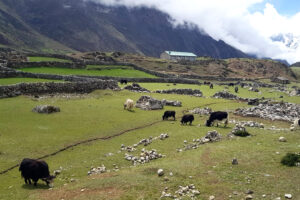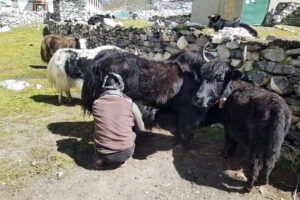Another unique inquiry from Nepal.
…….
Hello Alex sir,
Namaste from Solukhumbu region. I am a yak herder and I have some grass field. We used to harvest the grass with the sickle, as an old tradition in Khumbu. Some people have brought the grass cutter machine but due to the high altitude, the machine couldn’t perform well. Also, the oil is very expensive, and the machine is hard to maintain. I did some search on google and I found your interesting video about the scythe. The scythe performs well, with high efficiency. No engine and oil is required. I would like to request you, is there any place you have contact to sell in Nepal. It would be very helpful for me and my community. Thank you very much for your time and consideration. I will be looking forward to hearing from you.
Warm regards,
Tashi
…….
Yaks play an extremely important role in the Sherpas’ lives. Yaks carry supplies on the mountain trails, yak milk is indispensable in Sherpas’ diet and yak wool has been traditionally used for making clothing and carpets. For a good part of the year, when not on the trail, yaks are freely grazing where possible. However, to sustain yaks in high elevations through the cold winter season, yak herders need to provide them with additional feed in the form of hay.
In the Himalayan region, hay is cut after the monsoon season. Hay fields are defined by stone walls to prevent random grazing. Until recently, cutting has been done by sickles, which is very laborious and time-consuming.
If the hay can’t be made locally, it needs to be brought from the lowlands. This is done, of course, on the back of yaks, two bales at a time.
Recently, motorized grass cutters were introduced to the region. However, this alternative presents its own challenges. Fuel has to be brought to the hills in baskets by foot. Machines require maintenance and are breaking often. The noise echoes through the pristine mountainsides.
Tashi ordered some scythes from Vikalp in India, but by the time the scythe outfits reached Kathmandu, it was too late for them to reach Solukhumbu in time. The haying season started in early August this year. Even though a number of yak herders were eager to try scythes, they resumed the use of brush cutters.
Here you can view a short video clip of cutting hay with a brush cutter.
When Tashi sent me this video clip of a brush cutter being used for their haying application, I observed another concern. Because the vibrating machine is hard to control, the blade is often scraping the soil while cutting. This will not only compromise the quality of the hay, but it will also set back the regrowth of the grass. The hayfield in the video would benefit from a nourishment, rather than hindrance.
In my opinion, using a motorized brush cutter for cutting the hay is a good example of inappropriate technology. I agree that using a sickle for gathering hay is time-consuming and labour intensive. A natural evolution would suggest that a scythe would be a sensible alternative for a yak herder’s needs and geography. Scythes are much more efficient and environmentally friendly. The efficiency grows with an improving user’s skill.
I can also see an attraction to motorized alternatives where noise is associated with ‘progress’, the blade is aggressive and nothing will stand in its way… and we’ve been told that manual methods are old-fashioned and the future belongs to mechanization. However, to choose a truly appropriate technology means to give consideration to all aspects of the given circumstances and then select the most suitable option.
I haven’t yet had the opportunity to visit the Solukhumbu region in person, so my opinions are based only on distant communication and common sense.
Now we’re planning ahead, to ensure that needed supplies are in Solukhumbu before the next haying season begins.





